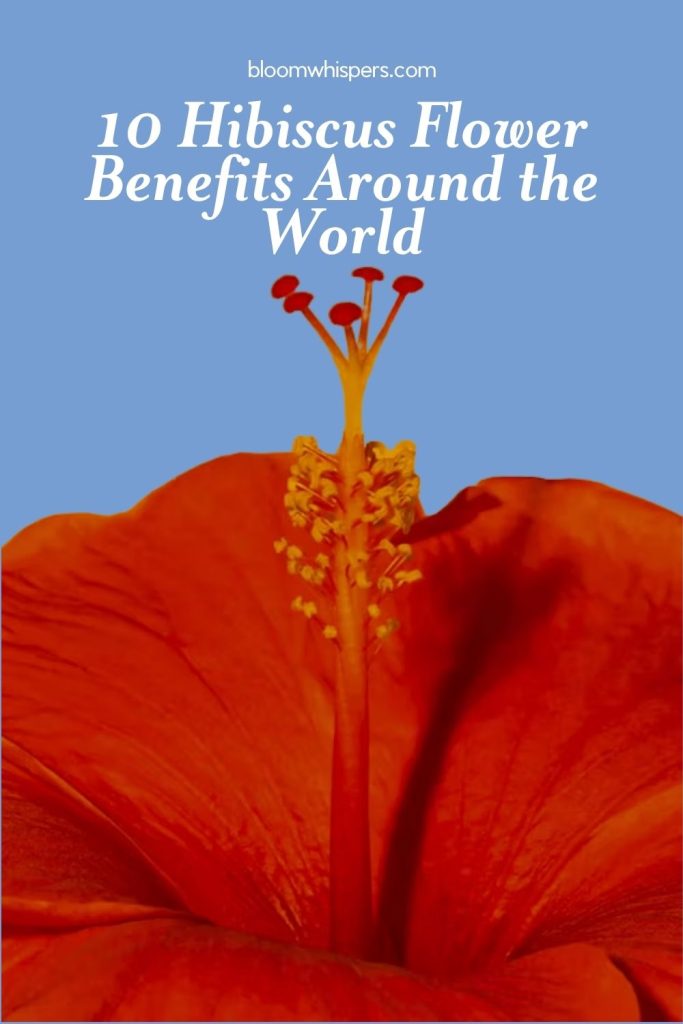- 10 Ways the World Uses the Hibiscus Flower for Energy, Beauty & Balance
- 1. India — The Flower of Strength and Transformation
- 2. China — The Ritual of Renewal and Everyday Care
- 3. Egypt — The Ancient Red Elixir
- 4. Nigeria — The Drink of Endurance
- 5. Jamaica — Sorrel for Cleansing and Joy
- 6. Hawaii — The Flower of Welcome and Warmth
- 7. Mexico — Agua de Jamaica for Everyday Balance
- 8. Pacific Islands — The Language of Love and Presence
- 9. Philippines — Cleansing Baths and Folk Healing
- 10. Modern Wellness — A Global Revival
- 📚 References
10 Hibiscus flower uses, From hair rituals in India to cooling drinks in Jamaica, the hibiscus flower keeps showing up where people want to feel alive, balanced, or beautiful.
Its deep red hue isn’t just striking — it’s chemistry. Hibiscus carries antioxidants, organic acids, and plant pigments that energize the body, soothe the skin, and calm the mind.
Here are ten ways the world still turns this bold bloom into daily rituals of beauty and balance.
10 Ways the World Uses the Hibiscus Flower for Energy, Beauty & Balance
1. India — The Flower of Strength and Transformation
In India, Hibiscus rosa-sinensis is both sacred and medicinal.
It’s offered to Goddess Kali and Durga as a symbol of power, fertility, and the divine feminine.
In Ayurveda, hibiscus is classified as cooling and rejuvenating, used to calm excess heat (pitta dosha) and nourish the body’s creative energy (ojas).
Its petals and leaves are crushed into hair pastes and herbal oils that strengthen roots, encourage growth, and prevent premature graying.
2. China — The Ritual of Renewal and Everyday Care
In China, Hibiscus rosa-sinensis is used in both folk medicine and home-based beauty care.
Herbal texts describe the flower as cooling, applied to reduce inflammation, clear heat from the body, and maintain radiant skin.
Dried petals are infused in coconut or sesame oil to condition hair, prevent dandruff, and restore shine — a practice recorded in regional ethnobotanical studies.
Hibiscus tea, often blended with chrysanthemum or honeysuckle, is consumed to support liver function and internal balance, reflecting the yin principle of gentle renewal.
3. Egypt — The Ancient Red Elixir
Ancient Egyptians brewed Hibiscus sabdariffa (known as karkadeh) into a ruby tea believed to purify the blood and strengthen the heart.
Consumed both hot and cold, it helped counter the desert heat and aided circulation.
Pharaonic tomb art and herbal records link hibiscus with life after the sun, a symbol of vitality and renewal.
4. Nigeria — The Drink of Endurance
Across West Africa, hibiscus is known as zobo in Nigeria and bissap in Senegal.
Made by boiling dried calyces with ginger or clove, the drink replenishes fluids, improves stamina, and supports cardiovascular health.
It’s a communal beverage, shared during fasting, celebrations, and family gatherings — a symbol of strength through unity.
5. Jamaica — Sorrel for Cleansing and Joy
In Jamaica, the holiday drink sorrel is made from H. sabdariffa, flavored with ginger, clove, and cinnamon.
It’s traditionally prepared during Christmas and New Year as a cleansing ritual, meant to “cool the blood” and clear stagnant energy before a fresh start.
Families steep, strain, and serve it with laughter — a joyful mix of medicine and celebration.
6. Hawaii — The Flower of Welcome and Warmth
In Hawaii, hibiscus is the state flower and a universal emblem of aloha — love, friendship, and openness.
Worn behind the ear, it conveys personal meaning: left side for taken, right for single.
It’s also used in floral leis, symbolizing warmth and inclusion.
7. Mexico — Agua de Jamaica for Everyday Balance
In Mexico, flor de Jamaica tea — made from H. sabdariffa — is served daily as a refreshing digestive tonic.
Rich in anthocyanins and vitamin C, it supports circulation and detoxification.
It’s also a symbol of hospitality, offered to guests as a gesture of warmth and welcome.
8. Pacific Islands — The Language of Love and Presence
Across the Pacific, the hibiscus carries subtle meaning in how it’s worn.
Placed behind the left ear, it means one’s heart is taken; behind the right, open to love.
It also adorns dancers, weddings, and community gatherings as a symbol of vitality and belonging.
9. Philippines — Cleansing Baths and Folk Healing
Hibiscus leaves and flowers are added to herbal baths and steam infusions to draw out fatigue and negative energy.
In folk medicine, the plant is used for skin conditions and cooling fevers, symbolizing purification and spiritual protection.
The bath ritual is often done at night — a quiet way to reset body and mind.
10. Modern Wellness — A Global Revival
Today, hibiscus is having a modern renaissance.
It appears in skincare, teas, supplements, and aromatherapy — valued for its antioxidants, gentle acidity, and vivid color.
From spa treatments to morning lattes, hibiscus continues to embody the same principle of balance and renewal shared by every culture before us.
🌸 3-Second Lesson: What’s ancient often remains essential — hibiscus still restores, beautifies, and brings us back to center.
From temples and kitchens to spas and street markets, hibiscus carries one message:
Energy, beauty, and balance all begin in care.
Take a moment to discover which flower mirrors your own rhythm.
The Bloom Whispers Flower Ritual Quiz reveals the bloom that reflects your energy — and a small ritual to bring it into your everyday.




- 10 Ways the World Uses the Hibiscus Flower for Energy, Beauty & Balance
- Flower Recipes: 7 Delicious Ways to Use Dried Hibiscus Flowers
📚 References
- Traditional and Modern Uses of Hibiscus Plants. Henry Bamidele (2025), Journal of Herbmed Pharmacology.
- Hibiscus — Natural Herbal Living Magazine (2022).
- Ethnomedicine, Phytochemistry, and Bioactivities of Hibiscus sabdariffa L. (JHP 2022).
- International Journal of Chemical and Biological Sciences (IJCBS), Khan et al. (2017).

